
The Gruiformes are an order containing a considerable number of living and extinct bird families, with a widespread geographical diversity. Gruiform means "crane-like".

Opisthocomidae is a family of birds, the only named family within the order Opisthocomiformes. The only living representative is the hoatzin which lives in the Amazon and the Orinoco delta in South America. Several fossil species have been identified, including one from Africa and one from Europe.

Phorusrhacids, colloquially known as terror birds, are an extinct family of large carnivorous, mostly flightless birds that were among the largest apex predators in South America during the Cenozoic era. Their definitive fossil records range from the Middle Eocene to the Late Pleistocene around 43 to 0.1 million years ago, though some specimens suggest that they were present since the Early Eocene.
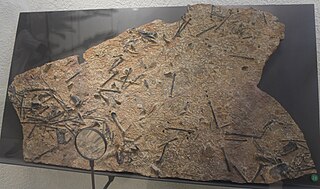
Presbyornis is an extinct genus of presbyornithid bird from North America during the Paleogene period, between the Late Paleocene and Early Eocene.
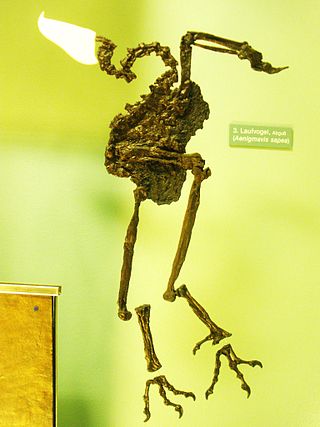
Strigogyps is an extinct genus of prehistoric bird from the Middle Eocene to Early Oligocene of France and Germany. It was probably around the size of a large chicken or a guan, weighing not quite 1 kilogram (2.2 lb). Apparently, as indicated by the ratio of lengths of wing to leg bones, S. sapea was flightless. Its legs were not adapted to running, so it seems to have had a walking lifestyle similar to trumpeters. Unlike other Cariamiformes which appear to have been mostly carnivorous, the specimens of one species, Strigogyps sapea, suggest a facultatively herbivorous or omnivorous diet.

Pangalliformes is the scientific name of a provisional clade of birds within the group Galloanserae. It is defined as all birds more closely related to chickens than to ducks, and includes all modern chickens, turkeys, pheasants, and megapodes, as well as extinct species that do not fall within the crown group Galliformes.
Lavocatavis is an extinct genus of prehistoric bird from the Eocene of Algeria. A fossilized femur was described from the Glib Zegdou Formation in 2011 and is the only known specimen of Lavocatavis. The species was designated L. africana.

Bathornithidae is an extinct family of birds from the Eocene to Miocene of North America. Part of Cariamiformes, they are related to the still extant seriemas and the extinct Phorusrhacidae. They were likely similar in habits, being terrestrial, long-legged predators, some of which attained massive sizes.
Paracrax is a genus of extinct North American flightless birds, possibly related to modern seriemas and the extinct terror birds. Part of Bathornithidae, it is a specialised member of this group, being cursorial carnivores much like their South American cousins, some species attaining massive sizes.
Eutreptornis is a genus of extinct possible cariamiforme bird from the Late Eocene of Utah. It is traditionally considered to be a bathornithid, though a combination of the relative incompleteness of the material alongside some differences from other bathornithids have raised some suspicions about this affiliation.

Bathornis is an extinct lineage of birds related to modern day seriemas, that lived in North America about 37–20 million years ago. Like the closely related and also extinct phorusrhacids, it was a flightless predator, occupying predatory niches in environments classically considered to be dominated by mammals. It was a highly diverse and successful genus, spanning a large number of species that occurred from the Priabonian Eocene to the Burdigalian Miocene epochs.
Elaphrocnemus is a genus of extinct bird from the Eocene and Oligocene periods of Europe. Part of Cariamiformes, its closest living relatives are seriemas, though it differs significantly from them, being a better flyer.
Geranoididae is a clade of extinct birds from the early to late Eocene and possibly early Oligocene of North America and Europe. These were mid-sized, long-legged flightless birds. Recent research shows that these birds may actually be palaeognaths related to ostriches.
Palaeophasianus is an extinct genus of flightless Geranoididae birds that lived in North America during the Eocene period. Robert Wilson Shufeldt classified Palaeophasianus as a galliform when he described it in 1913. However it was transferred to Cracidae in 1964 by Pierce Brodkorb, while Joel Cracraft in 1968 placed it in Gruiformes.
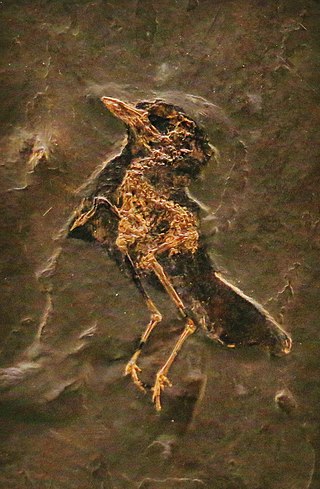
Zygodactylidae is a family of extinct birds found in Europe and North America from the Eocene epoch to the Middle Miocene. First named in 1971, based on fragmentary remains of two species from Germany, a more complete description of the birds became possible in 2008 when a number of other, better-preserved fossil species were assigned to the family based on a number of shared characteristics.
Austinornis is an extinct genus of prehistoric bird of uncertain phylogenetic placement from the Late Cretaceous of Texas. The paleontologist Julia A. Clarke named the genus in 2004 based on a partial tarsometatarsus fossil from Austin Chalk. Although Austinornis was thought to be a pangalliform, other researchers have disputed its classification and dismissed it in phylogenetic analyses due to the fragmentary nature of the holotype. Notably, in 2014, Gerald Mayr suggested that Austinornis is a non-neornithine from the Coniacian or Santonian age and that the specimen probably belongs to the ornithurine Apatornis or Iaceornis.
Danielsraptor is an extinct genus of masillaraptorid bird from the Early Eocene (Ypresian) Walton Member of the London Clay Formation in Essex, United Kingdom. The genus contains a single species, D. phorusrhacoides, known from a partial skeleton.
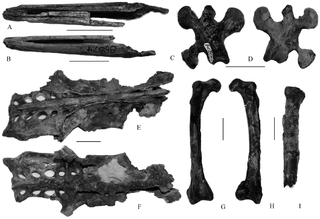
Tonsala is an extinct genus of Plotopteridae, a family of flightless seabird similar in biology with penguins, but more closely related to modern cormorants. The genus is known from terrains dated from the Late Oligocene of the State of Washington and Japan.
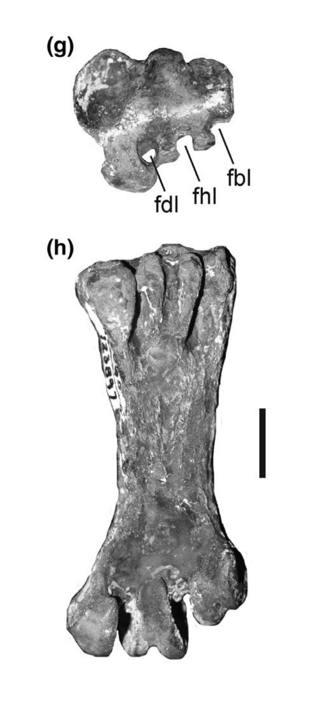
Phocavis is an extinct genus of flightless seabird, belonging to the family Plotopteridae, and distantly related with modern cormorants. Its fossils, found in the Keasey Formation in Oregon, are dated from the Late Eocene.

Olympidytes is an extinct genus of Plotopteridae, a family of large, flightless marine bird superficially similar to modern penguins but more closely related to cormorants and gannets. It lived during the Late Eocene or the Early Oligocene, in what is today the State of Washington and Japan.













